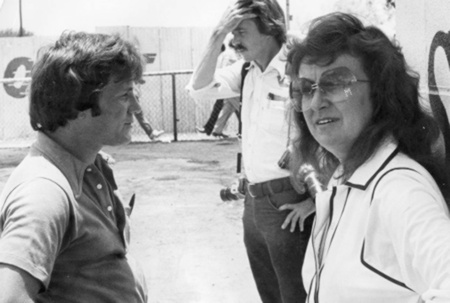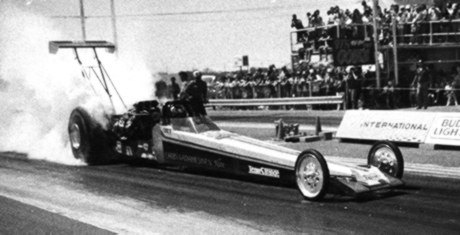 |
The AHRA / ADRA Split
 |
Georgia Miller and Jim Tice Jr.
at Alamo Dragway, San Antonio during the mid- to late '70's. |
Sometime in late 1980, Jim Tice Sr., was diagnosed with terminal pancreatic
cancer. As he got sicker, Jim's wife Ruth and Georgia Miller booked the
racers and Jim Jr. ran the events. Due to the severity of Tice Sr.'s illness,
obviously some type of contingency plans had to be made for his departure.
What developed in the beginning seemed to make sense.
"When Jim was sick, we talked a lot with him," said Moe. "We had a
group of AHRA track operators, Tice Jr., Gerald Pritchard at Tulsa,
George Eisenhardt at Dragway 42, Chuck Harmon Sr. at Kansas City, and
myself, and basically it was agreed among us that we would collectively
buy the business from his wife, Ruth, when he died.
"It looked like that was the way we were going to go, that we would
run the association Grand American collectively. Ruth did want to run
the track a little longer. So we figured okay, we'd help her out and
keep AHRA afloat. Jim died in 1982 and we ran the organization for her
until about mid-1984."
The AHRA track owners made up what were called the AHRA Regional Vice
Presidents and their opinion on the future of the association counted
for a lot. Still, there was the headquarters staff and the actual headquarters
vice-president was Don Garlits. He had a different path for Mrs. Tice
and recommended that Ruth sell the association to Mike Gray, who was
the president of Terminal Van Lines in Florida and very interested in
buying AHRA. Gray, while a successful businessman, had very limited
drag racing experience, most of it centered around his backing of Bo
O'Brochta's record-setting fuel motorcycle in the very early 1980's.
"We talked to her about it," said Moe, "but she decided to go with
Garlits' deal. When we heard about the deal, we talked to Gray, but
at that point I decided to step away. Jim, before his death, made personal
agreements that any track operator could cancel any agreements with
AHRA if they were unhappy for any reason after his death, and I decided
to exercise my option."
Tice Jr., had an explanation as to why Moe might've been unhappy with
the buy-out by Gray.
"Orville had been offered the contract by Ruth originally, but the
wording stated that he would be responsible for any known and unknown
debts," said Jim Jr. "Well, there were obvious weaknesses there.
"As for myself, my dad had verbally said that I would get 25-percent,
but that was not handled when he died. I had no proof short of my word.
Personally, my step-mother, Ruth, and I have never been close and we
did have some problems. In the last year we had AHRA, I ran it and we
made in the neighborhood of $750,000, but she also had run up some huge
debts and had developed some tax problems and needed money. She first
offered the deal to sell AHRA to Orville, but he declined. However,
along came Mike Gray and there it was."
Gray, according to some of the AHRA track owner survivors, was gung-ho
for all-Pro shows at upcoming AHRA events, but the association agreed
that this was flawed thinking.
As Tice put it, "When the whole deal is done, you don't want to lose
your Sportsman racers. They buy the majority of parts and count for
a goodly part of the profit margin that comes out of the races."
Seeing the decision Mrs. Tice made, Moe, Pritchard, Harmon, Eisenhardt
and the other track owners decided to go with a slightly different plan
and run another association collectively. Gray had bought the "AHRA"
name in mid-1984, so the old guard created the American Drag Racing
Association (ADRA) and ran their own races. The first event was held
at Dragway 42 on July 19-22 at West Salem, Ohio, Kansas City International
on Aug. 2-5, and Spokane Raceway Park, Aug. 16-19.
 |
| Chris "the Greek" Karamasines at Tulsa in
1984. |
 |
page 5 of 6
|
|
|